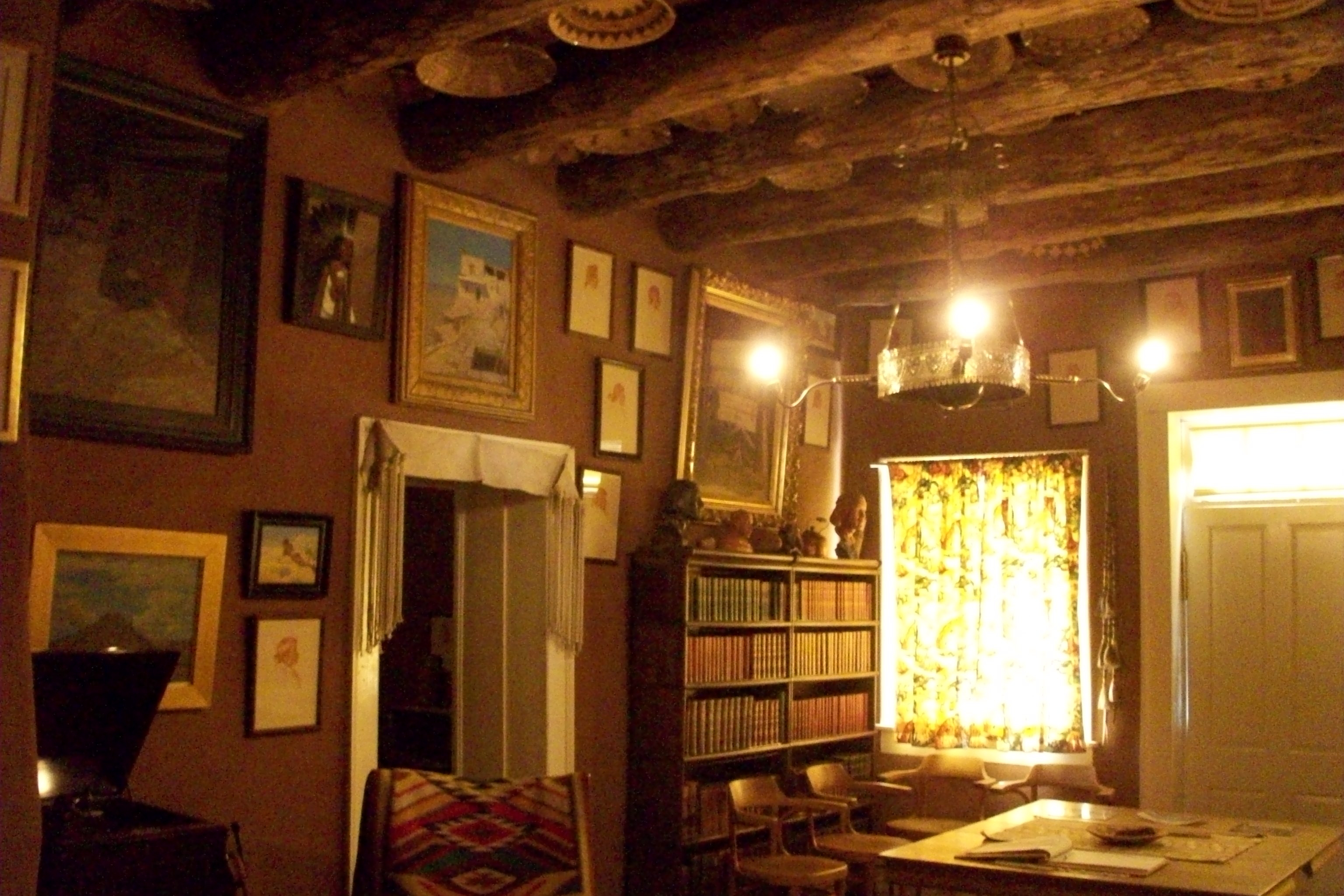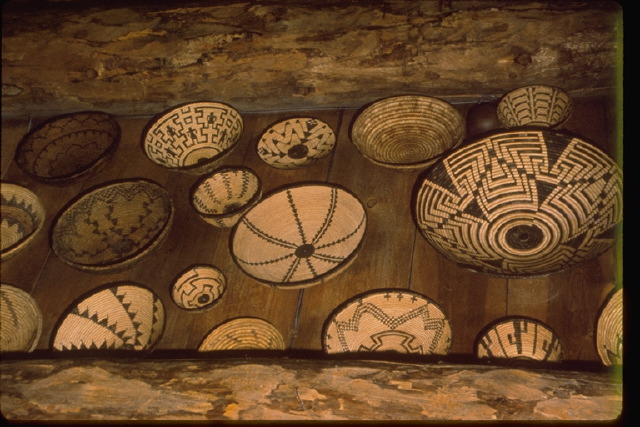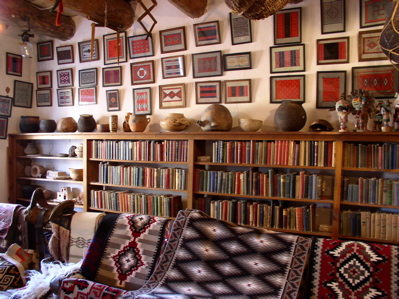Hubbell Trading Post National Historic Site on:
[Wikipedia]
[Google]
[Amazon]
Hubbell Trading Post National Historic Site is a historic site on Highway 191, north of Chambers, with an exhibit center in


 Hubbell family members operated this trading post until it was sold to the
Hubbell family members operated this trading post until it was sold to the 
American Southwest, a National Park Service ''Discover Our Shared Heritage'' Travel Itinerary
* * * * * {{authority control 1965 establishments in Arizona Buildings and structures in Apache County, Arizona Geography of the Navajo Nation Historic American Buildings Survey in Arizona Historic house museums in Arizona Museums in Apache County, Arizona National Historic Sites in Arizona National Historic Landmarks in Arizona Native American museums in Arizona Protected areas established in 1965 Protected areas of Apache County, Arizona Trading posts in the United States National Register of Historic Places in Apache County, Arizona
Ganado, Arizona
Ganado ( nv, ) is a chapter of the Navajo Nation and census-designated place (CDP) in Apache County, Arizona, United States. The population was 1,210 at the 2010 census.
Ganado is part of the Fort Defiance Agency, of the Bureau of Indian A ...
. It is considered a meeting ground of two cultures between the Navajo and the settlers who came to the area to trade.
History
In 1878, John Lorenzo Hubbell purchased this trading post, ten years after Navajos were allowed to return to the Ganado region from their U.S.-imposed exile inBosque Redondo
Fort Sumner was a military fort in New Mexico Territory charged with the internment of Navajo and Mescalero Apache populations from 1863 to 1868 at nearby Bosque Redondo.
History
On October 31, 1862, Congress authorized the construction of F ...
, Fort Sumner
Fort Sumner was a military fort in New Mexico Territory charged with the internment of Navajo and Mescalero Apache populations from 1863 to 1868 at nearby Bosque Redondo.
History
On October 31, 1862, Congress authorized the construction of For ...
, New Mexico
)
, population_demonym = New Mexican ( es, Neomexicano, Neomejicano, Nuevo Mexicano)
, seat = Santa Fe
, LargestCity = Albuquerque
, LargestMetro = Tiguex
, OfficialLang = None
, Languages = English, Spanish ( New Mexican), Navajo, Ke ...
. This ended what is known in Navajo history as the "Long Walk of the Navajo
The Long Walk of the Navajo, also called the Long Walk to Bosque Redondo ( nv, Hwéeldi), was the 1864 deportation and attempted ethnic cleansing of the Navajo people by the United States federal government. Navajos were forced to walk from t ...
."
It was declared a National Historic Landmark
A National Historic Landmark (NHL) is a building, district, object, site, or structure that is officially recognized by the United States government for its outstanding historical significance. Only some 2,500 (~3%) of over 90,000 places listed ...
in 1960.
Navajo people
When the Navajos returned from The Long Walk in 1868, they found their herds decimated, their fields destroyed. Their way of life was ripped apart and their life was forever changed. The Navajos were troubled by an economic depression in the late 19th century as a result of the Long Walk. Thus, trade became increasingly important. Heavysandstone
Sandstone is a clastic sedimentary rock composed mainly of sand-sized (0.0625 to 2 mm) silicate grains. Sandstones comprise about 20–25% of all sedimentary rocks.
Most sandstone is composed of quartz or feldspar (both silicates ...
s from the area were quarried in 1883 to begin construction of this solid building along the southern banks of the Pueblo Colorado Wash. Life at Hubbell Trading Post centered around it. The idea of trading was not new to the Navajos. Native American tribes in the Southwest had traded amongst themselves for centuries. During the four years' internment at Bosque Redondo, Navajos were introduced to many new items (e.g., flour, sugar, coffee, baking powder, canned goods, tobacco, tools, cloth, etc.). When the Anglos came to trade with the Navajos, the difference was in the products exchanged, and in the changes brought about by these exchanges. Traders like Hubbell supplied these items.
Trade with men like Hubbell became increasingly important for the Navajos. The trader was in contact with the world outside the newly created reservation; a world which could supply the staples the Navajos needed to supplement their homegrown products. In exchange for the trader's goods the Navajos traded wool, sheep and, later, rugs, jewelry, baskets and pottery. It was years before cash was used between trader and Navajos.

 Hubbell family members operated this trading post until it was sold to the
Hubbell family members operated this trading post until it was sold to the National Park Service
The National Park Service (NPS) is an agency of the United States federal government within the U.S. Department of the Interior that manages all national parks, most national monuments, and other natural, historical, and recreational propert ...
in 1967. The trading post is still active, operated by the non-profit Western National Parks Association
Western may refer to:
Places
*Western, Nebraska, a village in the US
*Western, New York, a town in the US
* Western Creek, Tasmania, a locality in Australia
*Western Junction, Tasmania, a locality in Australia
*Western world, countries that i ...
, which maintains the trading traditions the Hubbell family established.
Today, Hubbell Trading Post National Historic Site is still situated on the original homestead
Homestead may refer to:
*Homestead (buildings), a farmhouse and its adjacent outbuildings; by extension, it can mean any small cluster of houses
* Homestead (unit), a unit of measurement equal to 160 acres
*Homestead principle, a legal concept t ...
, which includes the trading post, family home, out buildings, land and a visitor center. Visitors can experience this historic trading post on the Navajo Nation
The Navajo Nation ( nv, Naabeehó Bináhásdzo), also known as Navajoland, is a Native American reservation in the United States. It occupies portions of northeastern Arizona, northwestern New Mexico, and southeastern Utah; at roughly , the ...
, which includes weaving
Weaving is a method of textile production in which two distinct sets of yarns or threads are interlaced at right angles to form a fabric or cloth. Other methods are knitting, crocheting, felting, and braiding or plaiting. The longitudinal ...
demonstrations; and the store still maintains a wooden floor and walls from the days of old. A set of initials carved on the gate of the privacy wall which separates the public spaces from the private stand for John Lorenzo Hubbell.

Hubbell's life
Hubbell's father was Anglo, his mother Spanish. He was raised in Pajarito Mesa, New Mexico, a small village just south of Albuquerque, New Mexico. He came to this area in 1876, less than ten years after the Long Walk. In 1878 he bought the small buildings comprising the compound from a trader named William Leonard, and started business. He was twenty-three years old, single and trying to make a living among the Navajos, a people he did not know very well. He had to find a niche in a new culture, a difficult language. He probably learned "trader Navajo" very quickly. John Lorenzo was trilingual. He spoke English, Spanish and Navajo. Mr. Hubbell married a Spanish woman named Lina Rubi. They had two sons and two daughters. Additions to the family home to accommodate the growing family were finished in 1902. It started out as a plain adobe building which the Hubbell family gradually made into a comfortable, and in some ways, luxurious home. Paintings and artifacts and many large Navajo rugs still decorate the interior. Unlike other traders who left their families "back home" in the east, the entire Hubbell family spent most of the year in the village of Ganado. The Hubbells lived in the house until 1967. The guest house was built in the early 1930s by Roman and Dorothy Hubbell, Mr. Hubbell's son and daughter-in-law, as a tribute to Mr. Hubbell. Dorothy Hubbell carved the inner wooden door. Visitors stayed in the Hubbell home, such as artists who were interested in the color and shapes of the land; anthropologists who came to Mr. Hubbell for information; statesmen; friends of the family; and ordinary travelers in need of a place to stay. Architecturally, the guest house is in the Hogan (pronounced hoe-gone) (Navajo for home) style. Most hogans are built of logs, and the door always faces the east. Hogans are one-room dwellings and usually have six or eight sides. Mr. Hubbell built several traditional hogans on the grounds for the Navajos who came long distances to trade. The guest house was originally called Pueblo Colorado (the inscription over the door) but often was confused with the town of Pueblo, Colorado. There was an important Navajo leader named totsohnii Hastiin (pronounced Toe-so-knee haaus-teen) (Navajo for "man of the big water clan"). He was also called Ganado Mucho (pronounced gah-nah-doe-moo-cho) (Spanish for "many cattle") and Mr. Hubbell renamed this place Ganado for him. Ganado Mucho had a son, Many Horses, who is buried on the property. Beyond the perimeter wall to the north courses the Pueblo Colorado Wash, the northern boundary of the Hubbell settlement. In some sections of the Ganado-Cornfields valley, the wash is spring-fed and runs year round. Melting snows in spring and heavy summer rains sometimes cause it to flood. In the Southwest a good source of water has always attracted people. The Anasazi (pronounced ah-nuh-saa-zee) (Navajo for "the ancient ones") lived in small villages up and down the valley hundreds of years ago. The Navajos came later, and then the traders - all attracted to the source of water. The cone-shaped hill located northwest of the trading post is Hubbell Hill. The family cemetery is at the top. Mr. Hubbell, his wife, three of his children, a daughter-in-law, a granddaughter, and a Navajo man named Many Horses are buried there. Many Horses was one of the local herdsmen and the son of Ganado Mucho. He and Mr. Hubbell were close friends for many years. Mr. Hubbell maintained a friendship with many of his customers until his death in 1930. Then his younger son Roman operated the business. When Roman died in 1957, his wife Dorothy managed the store for another ten years, until 1967 when the National Park Service acquired the site. Built with juniper logs upright in the ground, the corrals of the trading post held lambs and sheep purchased from Navajo stockmen by Mr. Hubbell. The flocks stayed in the corral complex until they could be herded to the railroad. From time to time Mr. Hubbell kept beef cattle as well. Mr. Hubbell homesteaded before they were part of the reservation and territory. When the reservation expanded, it surrounded the Hubbell property. Through an act of Congress Mr. Hubbell got permission to keep his home. Freight wagons brought supplies fifty-six miles to the store from the little railroad town of Gallup, New Mexico, two to four days' travel in good weather. Going back to Gallup, freight wagons hauled huge sacks of wool.Construction
Construction of the trading post barn began in 1897. The builders, local people, made the walls of local sandstone and the roofs fashioned in the ancient Anasazi-style dwellings. Ponderosa pine beams, aspen poles, juniper bark, cornstalks, and dirt make up layers, each at right angles to the one below it. Mules and pulleys lifted the beams into place. The timbers came from about east of Ganado Village where it is high enough for Ponderosa to grow. The aspen poles came from farther away in theChuska Mountains
''
The Chuska Mountains are an elongate range on the southwest Colorado Plateau and within the Navajo Nation whose highest elevations approach 10,000 feet. The range is about 80 by 15 km (50 by 10 miles). It trends north-northwest and is cross ...
that straddle the Arizona/New Mexico state line one hundred miles north to the intersection with Colorado and Utah. The barn was completed in 1900.
See also
* * *National Register of Historic Places listings in Apache County, Arizona
This is a list of the National Register of Historic Places listings in Apache County, Arizona. It is intended to be a complete list of the properties and districts on the National Register of Historic Places in Apache County, Arizona, United Sta ...
* Navajo trading posts
References
Further reading
* Erica Cottam (2020), ''Hubbell Trading Post: Trade, Tourism, and the Navajo Southwest'', University of Oklahoma Press ,External links
* *American Southwest, a National Park Service ''Discover Our Shared Heritage'' Travel Itinerary
* * * * * {{authority control 1965 establishments in Arizona Buildings and structures in Apache County, Arizona Geography of the Navajo Nation Historic American Buildings Survey in Arizona Historic house museums in Arizona Museums in Apache County, Arizona National Historic Sites in Arizona National Historic Landmarks in Arizona Native American museums in Arizona Protected areas established in 1965 Protected areas of Apache County, Arizona Trading posts in the United States National Register of Historic Places in Apache County, Arizona